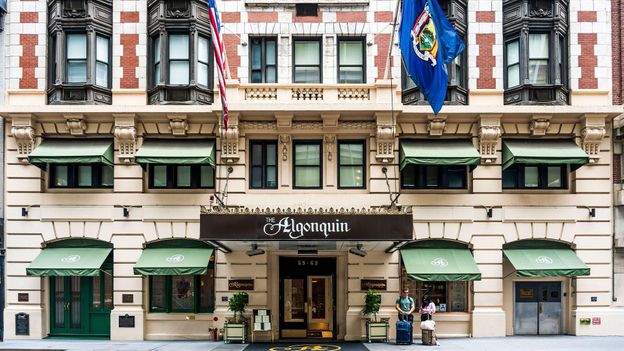
By Tony Perrottet,Features correspondent
 Alex Mastro/Alamy
Alex Mastro/AlamyFrom The Chelsea Hotel to The Algonquin to Albertine, NYC is full of famous literary hubs that have shaped the city’s culture. Follow this guide to experience eight of the very best.
New York City has been the US’ undisputed literary capital since the days when Herman Melville and Edith Wharton were scribbling away. In the generations since, the city has steadily lured wordsmiths from around the world seeking inspiration amid the city’s “high growths of iron… splendidly uprising toward clear skies”, as local boy Walt Whitman rhapsodised in his 1860 poem Mannahatta.
Today, New York City is still the powerhouse of the US publishing industry and is arguably home to the greatest concentration of writers on the planet. Far from being reclusive, the city’s scribes tend to be an uproariously social and hedonistic bunch. As a result, many of the most cherished literary shrines, bookstores, bars, restaurants, hotels and clubs from the past continue to thrive today, attracting fresh armies of bohemians to share editorial war stories, celebrate their victories and (often enough) drown their sorrows.
All this is good news for bibliophile travellers eager to explore New York’s ever-morphing literary landscape. The main challenge is that any survey must be shamelessly opinionated. And so, for my money, the key “must-sees” are as follows:
 Yevgenia Gorbulsky/Alamy
Yevgenia Gorbulsky/AlamyThe reopening of “The Chelsea” in 2022 after an 11-year renovation is a boon for fans of New York literary history. In fact, when it comes to famous writers, the question is: Who didn’t stay in the distinctive red-brick Victorian edifice looming over 23rd Street in Manhattan? Mark Twain held forth here soon after it opened its doors in 1884, but it hit its stride as a cheap writer’s refuge in the mid-20th Century, becoming the temporary home of Arthur Miller (who moved here after separating from Marilyn Monroe); Simone de Beauvoir; Dylan Thomas (who went into a whiskey-induced coma here; see stop #8 below); Tennessee Williams; Jack Kerouac (who had a one-night stand with Gore Vidal here) and Arthur C Clarke, amongst countless others.
In the 1960s, the hotel became famous for the cast of young poet-musicians who took up residence here, including Bob Dylan, Leonard Cohen, Janis Joplin, Joni Mitchell and Patti Smith.
Today, the renovated Chelsea is something of a self-contained bohemian entertainment complex, worth planning an evening around even if you can’t afford to stay. Start with delicious sangria, papas bravas and “shrimp in green sauce” beneath the Cervantes-themed murals at the hotel’s beloved Spanish restaurant El Quijote, then head for martinis at the softly lit Lobby Bar. Sitting at the splendid Old World wooden counter beneath chandeliers and mirrors is still a marvellous experience, even though each cocktail might cost more than a week’s rent back in the glory days.
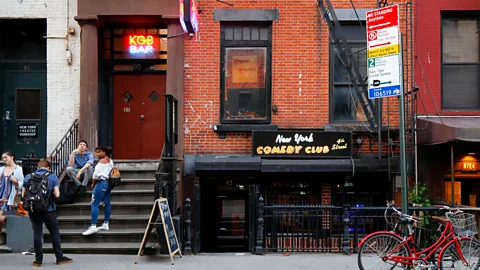 Robert K Chin – Storefronts/Alamy
Robert K Chin – Storefronts/AlamyDon’t be put off by the cheeky name: KGB actually stands for Krayne Gallery Bar, and the building started life back in the 1880s as a Ukrainian Socialist Club in the heart of the East Village’s “Little Ukraine” community. Its literary pedigree dates to the 1960s, when Beat poets and writers gave readings in the ground-floor theatre, but kicked into high gear after 1993 when it was purchased by lawyer and author Denis Woycuk. The venue soon became the reading venue of choice for downtown literati, luring everyone from creative writing students at nearby New York University to Jonathan Franzen, Joyce Carol Oates, David Foster Wallace, Elizabeth Gilbert and Anthony Bourdain.
There is an active theatre on the ground floor and almost-nightly literary events (poetry readings, book parties, storytelling events and open-mic nights) on the first-floor bar and the glamorous top-floor Art Deco speakeasy, The Red Room. The latter is where (full disclosure!) I now host The Last Taboos monthly salon with literary guests who have included David Grann, Paul Theroux, Abbott Kahler and Debbie Applegate. The owner, Woycuk, who can usually be found there cradling a gin fizz, is still the only bar owner to ever be nominated for a Publisher’s Weekly Star Award for promoting writers.
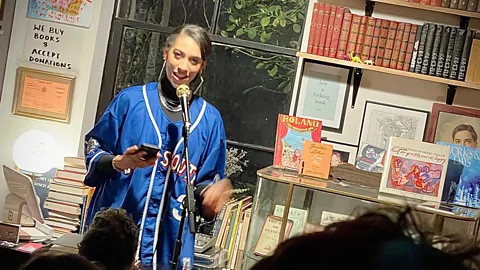 Tony Perrottet
Tony PerrottetIf any New York City bookstore could double as a speakeasy, it would be Black Spring Books, hidden on a quiet block in Williamsburg with only a stencilled name on the metal door to give away its location. Here, literary symmetries abound: it sits next to the childhood home of Henry Miller, who lived there from 1891 to 1901, when the neighbourhood was a feisty working-class community of Italian, Irish, German and Polish immigrants. Although Miller became notorious for his louche Parisian classic Tropic of Cancer published in 1934, the bookstore takes its named from his 1936 collection of autobiographical short stories Black Spring, many of which are about growing up in these once-wild streets.
Today, in a homage to Miller, its shelves are stacked with the work of young and emerging authors and books from small, offbeat presses, as well as the latest underground literary magazines. Defying the trend of recent bookstore closures in the city, Black Spring was opened during the depths of the pandemic in 2021 by Simona Blat, who – in another symmetry – was for many years assistant to the late Michael Seidenberg at the legendary Brazenhead, a speakeasy-style bookstore-within-an-apartment on the Upper East Side. Though now closed, Brazenhead’s tradition of raucous wine-fuelled gatherings is a centrepiece of Black Spring’s appeal, turning it into a social hub for the Brooklyn literary community today. They are all free and open to the public – check the website for the schedule.
Website: www.blackspringbookstore.com
Address: 672 Driggs Ave, Brooklyn, NY 11211
Instagram: @blackspringbooks
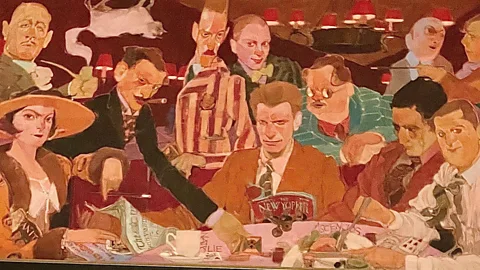 Tony Perrottet
Tony PerrottetAlthough it has endured various transformations over the last century, no tour of literary New York would be complete without sipping a cocktail at the Algonquin Hotel in the heart of Midtown near Times Square. The hotel became inseparable from the city’s Jazz Age literary mythology in 1919, when a group of sharp-tongued writers including Dorothy Parker, Robert Benchley, Alexander Woollcott and Harpo Marx agreed to meet there for boozy luncheons six days a week in an informal literary club, calling themselves the Round Table (today the name of the hotel restaurant), where they traded bon mots that are still repeated by admirers. (For example, from Benchley: “Why don’t you get out of that wet coat and into a dry martini?”)
The Algonquin remained a hub for years. From 1924, Parker only needed to go downstairs from her hotel room to join the lunch club at the bar; the first offices of The New Yorker magazine, which employed many of the scribes from 1925, were located around the corner. The magazine’s first editor, Harold Ross, would prowl “the Gonk” trying to get the writers to actually write. When asked why she wasn’t at the office, Parker once replied: “Someone was using the pencil.”
Last year, the Blue Bar and lobby of the hotel were renovated in a more contemporary style that may not be to all purists’ tastes, with original fittings like the imposing Greek columns painted glossy white. But there are still elements of Roaring Twenties style: keep an eye out for caricatures of the Round Table figures on the walls and ask to meet the famous “lobby cat”, or “feline concierge”, who is, like his predecessors over the decades, named Hamlet.
 Esra Karakose Balioglu
Esra Karakose BaliogluHidden in the heart of Museum Mile on Fifth Avenue in Manhattan’s Upper East Side, Albertine is New York’s most ravishing bookstore. It’s located within a palatial 1909 townhouse designed by the Gilded Age’s scandalous “starchitect” Stanford White (who also designed the Washington Square arch and was murdered by the jealous husband of one of his former mistresses in a suitably Shakespearean scenario). Since 1952, the mansion has housed the Cultural Services of the French Embassy, and since 2014, the bookstore Albertine, named after the fictional mistress of the narrator in Marcel Proust’s Remembrance of Things Past.
Visitors enter via a splendid marble-lined entry hall with a statue credited to Michelangelo, the Young Archer (well, today it’s a copy; the original was so valuable that it went on permanent loan to the Metropolitan Museum of Art across the street), and is flanked by a glittering Venetian Room lined with rococo mirrors and antique furnishings.
But the true attraction is literary: the bookstore nestled in the rear has 14,000 volumes in both English and French; a spectacular ceiling painting of astrological constellations in cobalt blue and gold; and busts of Gallic luminaries lining on the walls. With leather lounges and soaring windows, it’s the most aristocratic spot for writers to hide away in New York. There are also regular literary events, sometimes fuelled by bubbly – French, of course.
Website: www.albertine.com
Neighbourhood: Upper East Side
Address: 972 Fifth Avenue, New York, NY, 10075
Phone number: +1-332-228-2238
Instagram: @albertinebooks
 AA World Travel Library/Alamy
AA World Travel Library/Alamy6. St Marks Church-in-the-Bowery/The Poetry Project
In 1966, assorted cafe poetry groups coalesced to form The Poetry Project in an unusual venue: a stately 18th-Century church on the corner of East 10th Street and Second Avenue in the East Village. Consecrated in 1799, the church was built on land once owned by colonial Dutch settler Peter Stuyvesant, who was buried on the site. (The name “Bowery” comes from the Dutch word bouwerij, or farm, back when New York was New Amsterdam).
The site became an arty venue in the 1920s, with Greenwich Village locals like poet Edna St Vincent Millay joining gatherings and Martha Graham dancing. In the ’60s, the English-born poet WH Auden, who lived in a tenement on St Marks Place nearby (at number 77), was a parishioner. The Poetry Project began meeting at the church with the support of a community-minded rector named Reverend Michael Allen. For decades, its most famous guiding light was another East Village denizen: Allen Ginsberg, the “Master Poet of the Beat Generation”, who could be seen reading there until his death in 1997. (His last apartment, where he lived from 1975, is nearby at 437 East 12th St).
Today, the Poetry Project is still going strong, with readings and performances by up-and-coming bards several evenings a week, including (for the strong-of-spirit) an annual Poetry Marathon that lasts for a whopping 12 hours every New Year’s Day, and celebrating its 50th anniversary on 1 January 1 2024.
Website: www.poetryproject.org
Address: 131 East 10th St, New York, NY, 10003
Phone number: 001-212-674-0910
Instagram: @poetry_project
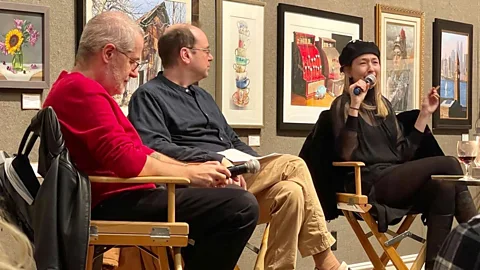 Tony Perrottet
Tony Perrottet7. The Coffee House Club/Urban Conspirators
Private members-only clubs are often associated with fusty London, but the streets of Manhattan are thick with them. One with a literary bent is the quirky Coffee House Club, which was founded in 1914, and whose location for conversation-filled get-togethers moved around various Midtown hotels over the last century. (Its name is a homage to the coffee houses of 17th-Century London that became hotbeds of literary and intellectual discussion).
In 2021, it took up residence in the storied Salmagundi Club on Lower Fifth Avenue in Greenwich Village. Originally aimed at fine artists, it is housed in a majestic 1871 townhouse whose wood-panelled halls lined with antique canvasses are a treat to visit. (Art exhibitions there are free and open to the public every afternoon; it’s the easiest way to explore the Gilded Age enclave).
The Coffee House Club now hosts regular book events and dinners: the most fun and casual are the Friday night events, which include readings and magazine launch parties, hosted by the younger wing of the club The Urbane Conspirators, founded, as one member told me, “in a rebellious yet well-attired spirit.” They are free and open to literary enthusiasts, but registration is required via the contact page of the club website.
Website: www.coffeehouseclub.org
Neighbourhood: Greenwich Village
Address: 47 Fifth Ave, New York, NY, 10003
Phone number: +1-843-810-0483
 Wendy Connett/Alamy
Wendy Connett/Alamy8. The White Horse Tavern
It may seem a dubious claim to fame that one of the 20th Century’s greatest writers drank himself to death in your bar. But the White Horse Tavern is unafraid to celebrate that Dylan Thomas, the then-39-year-old Welsh author who was on tour in New York in 1953, turned to a friend here one night and declared: “I’ve had my 18th straight whisky and I think that’s the record.” He somehow staggered the few blocks back to his room in The Hotel Chelsea (see above) and went into a coma; he died in hospital two days later.
Founded in 1880 as a bar for longshoreman working at the nearby Hudson River docks, the White Horse was, by Thomas’ time, one of the city’s most popular literary watering holes, frequented by James Baldwin, Anaïs Nin, Jane Jacobs and Norman Mailer. According to one legend, the idea for the famous alt-weekly newspaper, The Village Voice, was hatched here over drinks. According to another legend, a message to the bibulous Jack Kerouac was scrawled on the bathroom wall: “JACK GO HOME!”
Today, the White Horse remains one of the most charming bars in the city, with the (normally) decorous air of an English pub, and adorned with the odd photo of Thomas as a reminder of the bar’s pedigree. Although the writer was touring the United States purely to make money, it’s curious to note that his bar tab for 18 whiskies here would leave little change from $300 today, so he would surely have stuck to the daily happy hour from 16:00-18:00.
Website: www.whitehorsetavern1880.com
Address: 567 Hudson St, New York, NY 10014
Phone number: +1-212-989-3956
Instagram: @whitehorsetavern1880
(A long-time denizen of the East Village, Tony Perrottet is the author of six books and hosts the Last Taboos literary salon at the East Village speakeasy KGB Bar Red Room)






